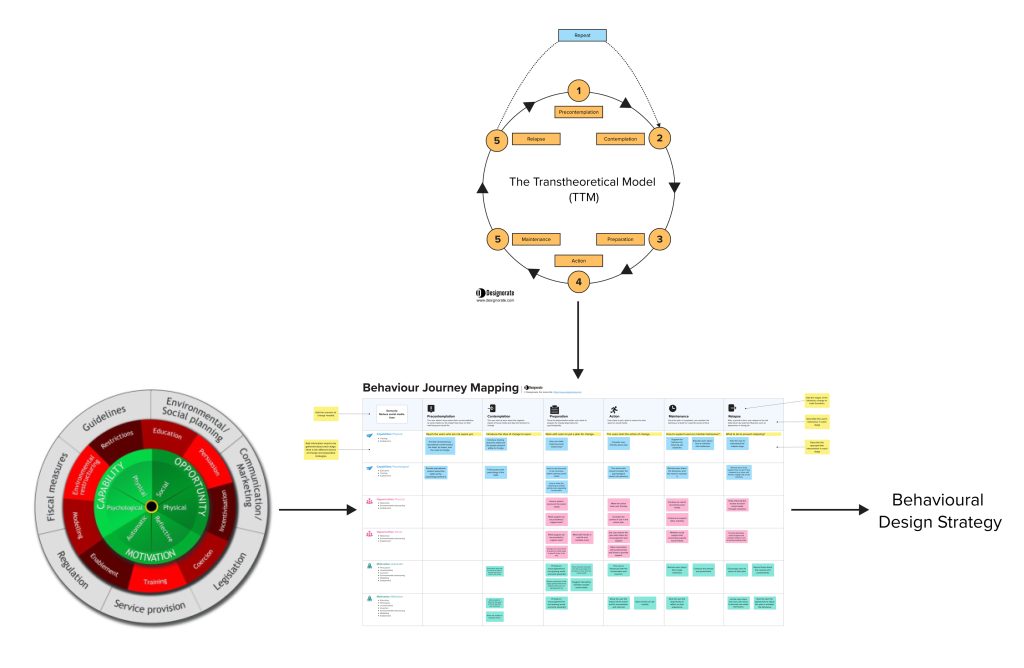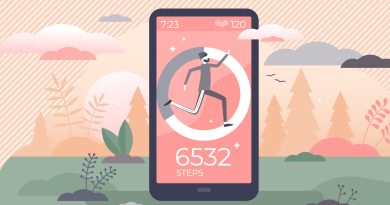Build Behavioural Design Strategy Using Journey Mapping
Consumer journey mapping is a practical tool to use in behavioural design to understand user behaviour and develop effective strategies to change behaviour for habit formation. During the design thinking process, many factors interact together, and at the core of these factors is the user’s behaviour as they interact with the design artefact. Eventually, to build a sustained impact of the design solution and an empathic relationship between the user and the product, behaviour change needs to be considered.
This article will use three tools to build a behaviour strategy for designing products and services: consumer journey mapping, the Transtheoretical Model (TTM) of behaviour, and the behaviour change wheel. You can use this paradigm to either plan for future new products or retrospectively investigate existing habits with specific products.
The outcome is a Behaviour Journey Map will inform us a behavioural design strategy when we design products and services. You can access the free Mural template for the map by clicking on the link at the end of the article.
What is the Consumer Journey Map?
Consumer Journey Mapping is a tool to help us explore the different touch points that the user interacts with the design, product, service, or system. Think of an online shopping experience. The users go from one step to another before, during and after doing the shopping. They see the ads about the online store; then they find a need to visit it, they go to the website, create an account, and move to the exploration and purchase process to different stages.
The consumer/user journey mapping aims to identify the experience they face with each touch point with the system. In my previous article, Customer Journey Mapping: A Complete Guide for Designers, we explored how to apply consumer journey mapping in detailed steps.
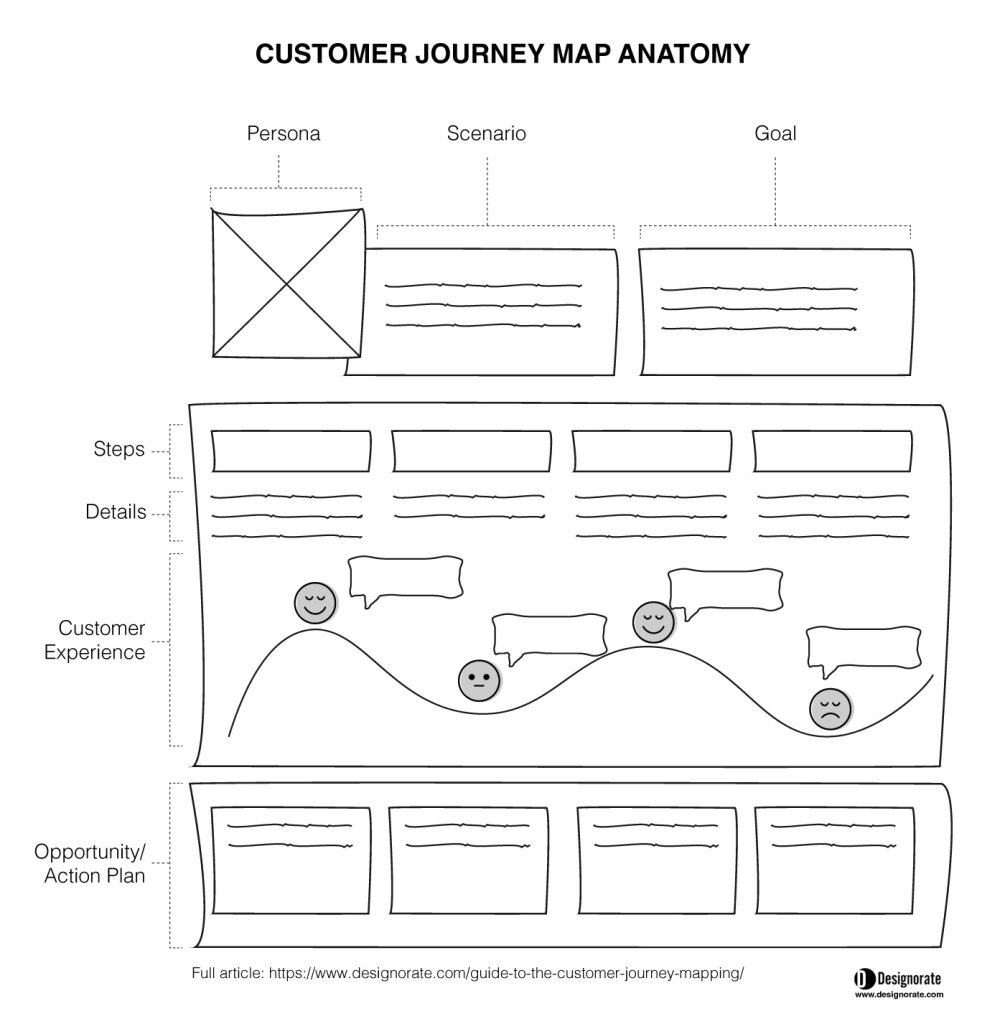
We can customise the consumer journey mapping to supply the information we need from the user and work with them to improve their experience. So, as we move from one step to another in the user interaction with the system, we learn about their motivation, satisfaction, and pain points, and we build a better understanding of how to improve the system to have better user engagement.
User Persona
People’s behaviour and interaction with the design system vary. Therefore, we need to identify the typical characteristics of the target user, which reflect the market segment. Therefore, we need to define a user persona. It is a fictional character with all the required user characteristics, demographics, and behaviour information. This information is usually gathered from user research such as user interviews, focus groups or questionnaires we conduct with the system’s potential users.
The information included in the user persona can vary depending on the target aim of using it. We should consider behaviour characteristics, influences, and habits to understand use behaviour. Understanding this information before conducting the consumer journey mapping helps us work with the user in a co-design environment to develop a behaviour strategy for the design outcome.
Mapping Behaviour Change: The Transtheoretical Model (TTM)
As mentioned earlier, we can customise the consumer journey mapping to collect the information we need regarding user experience. Therefore, we must specify the user’s behavioural status at each stage of the habit formation or behaviour change process to understand user behaviour. Several theories describe behaviour and habit formation, and it is probably complicated and impossible to apply them in practice. However, some theories have simplified the habit process in a way that we can efficiently utilise in behavioural design practice.
The consumer journey maps depend on two axes; the horizontal shows the different stages of user interaction with the system, in our case, the various stages before and after the behaviour. The vertical access includes user feedback, pain points, and experience. To trace the behaviour stages, we need to analyse the behaviour using stages-based theories such as the Transtheoretical Model (stages of change) or the Habit Loop.
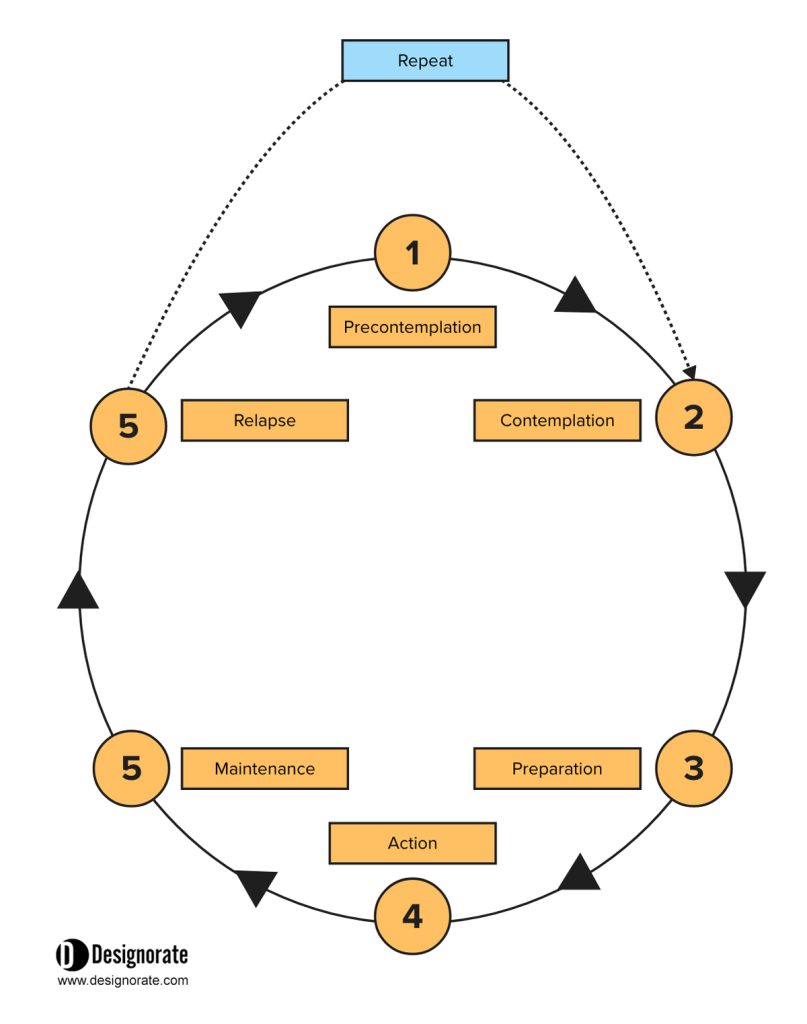
The Transtheoretical Model (TTM) is a stages-based behaviour theory developed in 1977 by James O. Prochaska and Carlo Di Clemente. The theory maps users’ behaviour in the long term and divides behaviour into six stages:
Precontemplation
At this stage, people aren’t aware of the behaviour and the need to change it. They are used to the current habits and are probably satisfied with them. Some call this stage the denial stage. For example, users spend many hours a day on social media. They may already know it affects their well-being (fear of missing out, anxiety, etc.), taking them from family or influencing their work. Still, they are OK with this and enjoying it (check Behavioural Design: Using Habit Loop in mHealth).
Contemplation
People start to see a point of change and become conscious that it needs to be done but are not yet ready. While the first stage is linked to the unconscious nature of habits, at this stage, they start to think about the habit consciously, such as thinking of the pros and cons of spending hours every day just scrolling.
Preparation
This is the point of change; users start to determine that a change is needed, and they must not hooked in the loop of the habit (e.g. social media addiction). As they start thinking about the habit, users may go and do some research and find more information about it, which can trigger their decision to change. But at this stage, it is just a decision; it has not yet transformed into action.
Action
Users start to change by building a plan to achieve this change. There are several techniques to do the change, such as the Hooked Model, which helps to create a behaviour change plan. Some tools can help identify the root causes of the habit and address the cause, such as the 5 Whys; other tools can be helpful to suggest alternative solutions, such as the SCAMPER. This change can be done in one step or gradually based on the behaviour. Social media users can start by progressively limiting the usage time or preventing it at a specific time of the day until reaching a reasonable usage pattern.
Maintenance
People maintain healthy habits and avoid any temptation to return to their previous habits. They are happy with the change and see it as their new healthy life. It doesn’t mean they forget the old habit because its experience is embedded in their brains. Still, they keep resisting it by ignoring this cognitive demand and proceeding to maintain the new habit. For example, instead of spending a long time on social media, users may use the time to play with their kids, go to the gym or cook.
Relapse
While several models didn’t refer to this stage, in reality, this is one of the core problems in behaviour change strategies. Many people relapse to old habits after spending some time maintaining their new healthy ones. And this is one of the significant challenges in behaviour change. We can’t build a coherent habit formation strategy without considering the possibility of relapsing. We need to know the real reasons behind relapsing and retiring to the old bad habits. It can be psychological, social, or economical. Losing a job can lead to depression and more time alone, which can lead to trapping the phone and spending more time on social media.
The relapse state returns with the people to point zero before the pre-contemplation stage. Of course, they can change their behaviour again, which means they will start with the 2nd stage of the model, the contemplation stage, as they already have an awareness of the behaviour and need just the trigger of the change again.
We can use the above six steps to present the stages of behaviour in the consumer journey map, or we can call it, in this case, the behaviour journey mapping (Figure 5).
Forming Behavioural Design Strategy: The Behaviour Change Wheel
I usually use the Behaviour Change Wheel to inform behavioural design strategies for its straightforward approach and practicality. The Behaviour Change Wheel (BCW) is a tool developed by Prof Susan Michie, Dr Lou Atkins, and Prof Robert West from University College London. It is based on 19 behaviour frameworks and has been tested in several contexts and critical trials.
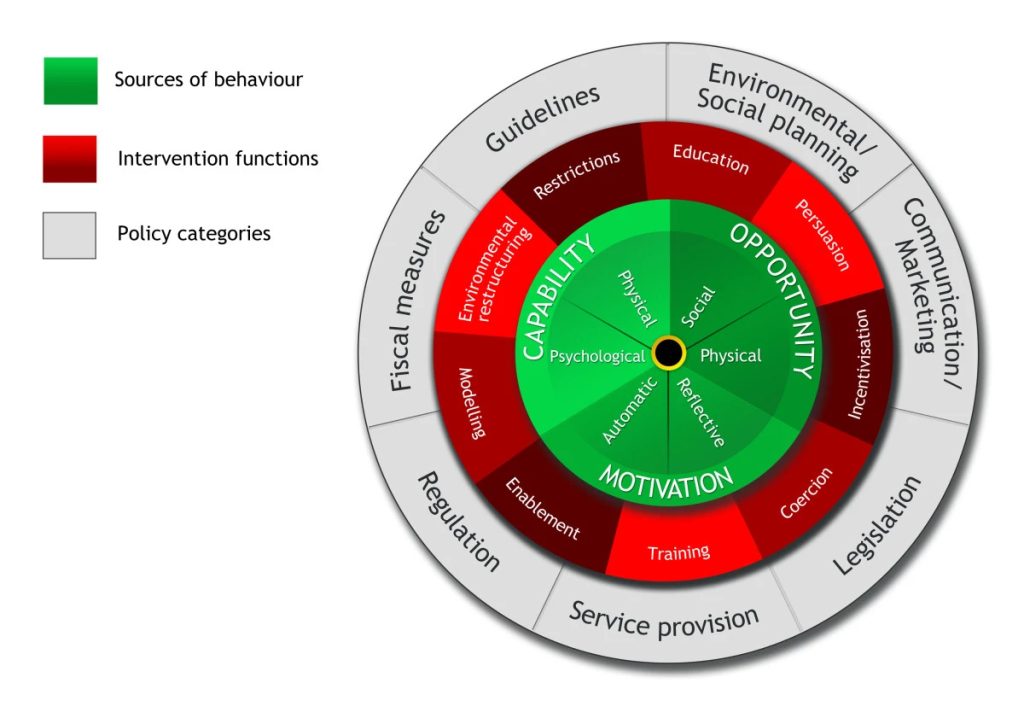
The BCW is based on the COM-B framework (the green central circle), which summarises the drivers of behaviour into three main categories (Figure 4):
- Capabilities (C): The person’s ability to do the behaviour, which can be physical or psychological.
- Opportunities (O): The current opportunity to make the change can be affected by the physical or social opportunity to drive the change.
- Motivation (M): The personal motivation to make the change can be automatic or reflective
The three components are the key drivers of change. People need to be motivated to make the change, but also, this requires the affordability of the behaviour (capabilities) and the right opportunity to achieve it. This framework is visualised by the green circle in the centre of the BCW, which presents the sources of behaviour.
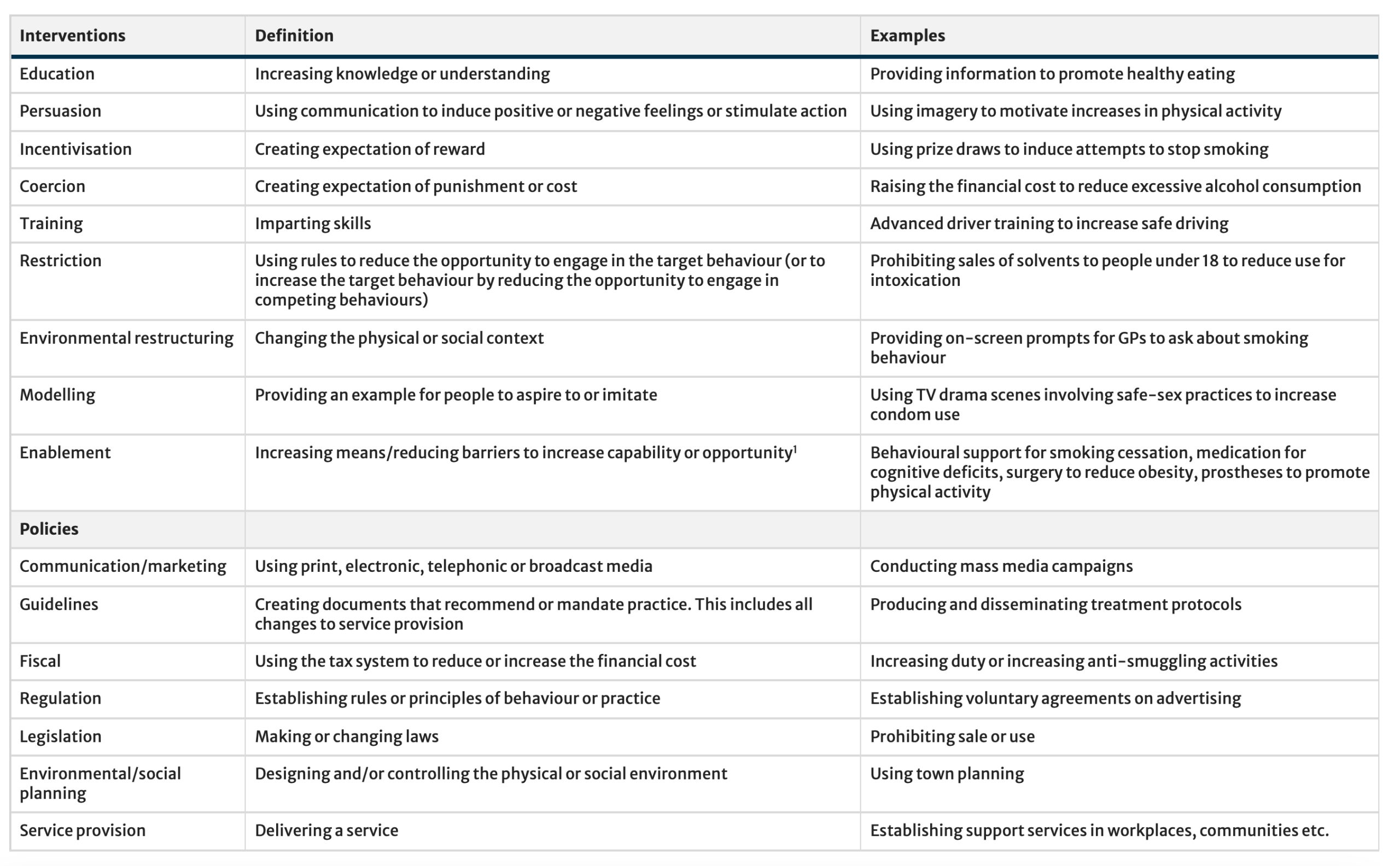
The middle circle includes nine intervention functions to drive the change. These functions are linked to the sources of behaviour. For example, the opportunity driver of behaviour can be addressed through several functions such as education, persuasion, incentivisation, and coercion. The outer circle of the BCW is the policy categories and provides guidelines for policymakers as they consider the different intervention functions. Table 1 describes functions and policies and provides examples of how they are used to drive behaviour change and form behavioural design strategies.
Table 2 describes this relationship between the functions, which will present the part of the design strategy we will use in the product or service and the drivers of behaviour. This relationship allows us to identify the interventions we need to use to address the behaviour in each of the six stages of behaviour we highlighted earlier.

Building the Behaviour Change Map
The behaviour change map uses the same structure as the consumer journey mapping. The horizontal stages show the anatomy of behaviour stages, where we can use models such as The Transtheoretical Model or the Habit Loop. The vertical axis shows the information we need to collect, identify or reflect on during the participatory research we do with the users (Figure 5). In the example below, the aim is to reduce social media usage to mitigate the consequences of mental and physical health. A participatory workshop can be conducted with sample users (personas) to map their behaviour through the six stages and address the behaviour we aim to change.
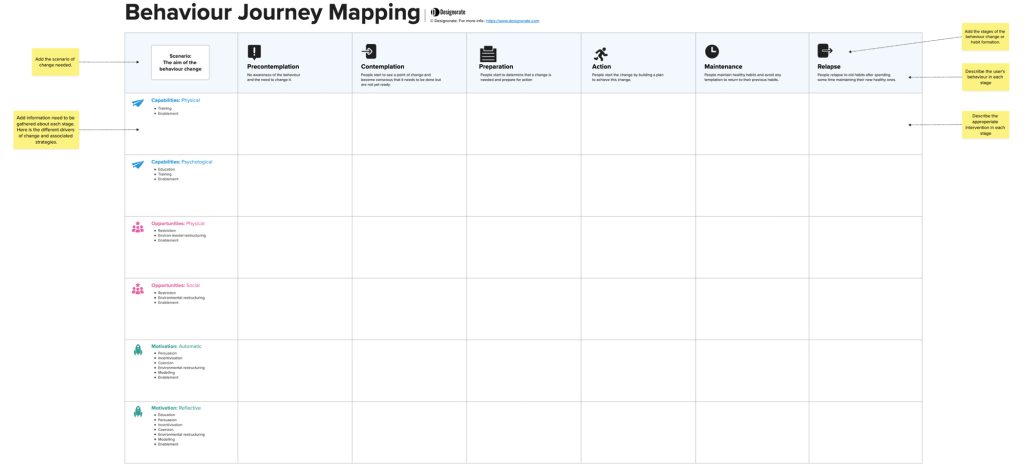
At each stage (Figure 6), we try to identify users’ experiences and how to respond with the appropriate strategy that targets behaviour drivers. In some states, the interaction is limited, such as the Precontemplation stage, as we need to spot and approach the users. Some other stages (e.g., Preparation and Action) involve many inputs that can feed into the final strategy and the functions to include in the final solution. While some people like to start by anticipating the outcome (e.g. mobile app), it is important not to jump to this until we have clarity about behaviour and the suggested strategies, as the final solution can differ from what we initially thought.
The drivers of behaviour (COM-B model) can be shared between the three elements (Capabilities, Opportunity and Motivation), and you can find that some ideas are shared across the different drivers. One interesting stage is the last one (Relapse), which requires planning to determine the actions to prevent it from happening and what to do to bring users to the (Action) again.
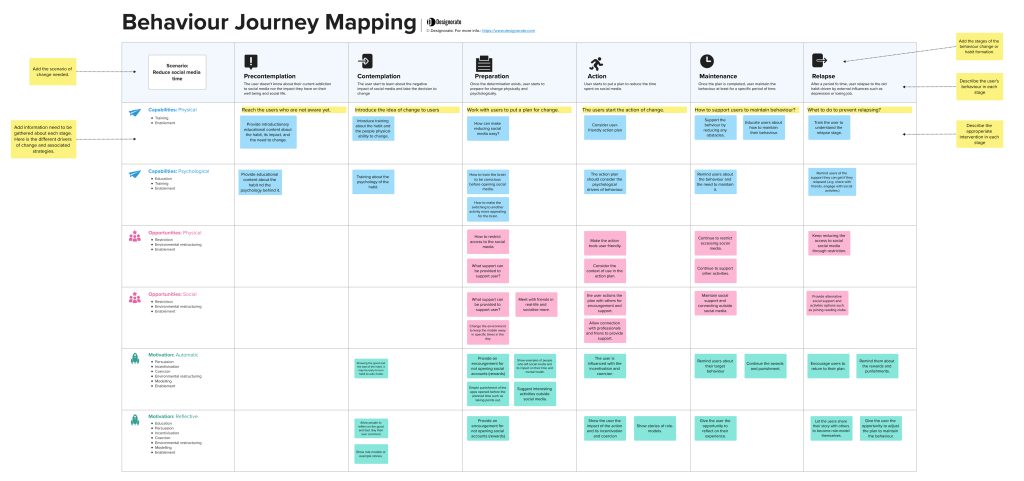
Feel free to download the above Mural template for the Behaviour Journey Map by clicking the below link:
Behaviour Journey Mapping Template
Once opening the link above, you can click New Mural from Template to import it and start working on it.
Building a behavioural design strategy for our design solution can be challenging, especially with the complex nature of behaviour itself. However, implementing the consumer journey mapping can help us break the behaviour into stages, making the process easier and more efficient and integrating behaviour models such as the Transtheoretical Model or the Habit Loop to inform us of the behaviour stages to consider in the journey mapping. Also, we can utilise the Behaviour Change Wheel and its COM-B model to guide us through the drivers of behaviour and how we can address each stage.
The above example utilises these models to build the Behaviour Journey Map, which can help us explore behaviour and develop behavioural design strategies. You can use the template in the example above in your design research stage to investigate the target behaviour and inform change strategy.
Bibliography
Clear, J. and Clear, J., 2018. Atomic habits: Tiny changes, remarkable results. Avery.
Michie, S., Van Stralen, M.M. and West, R., 2011. The behaviour change wheel: a new method for characterising and designing behaviour change interventions. Implementation science, 6, pp.1-12.
Prochaska, J.O. and Velicer, W.F., 1997. The transtheoretical model of health behavior change. American journal of health promotion, 12(1), pp.38-48.

